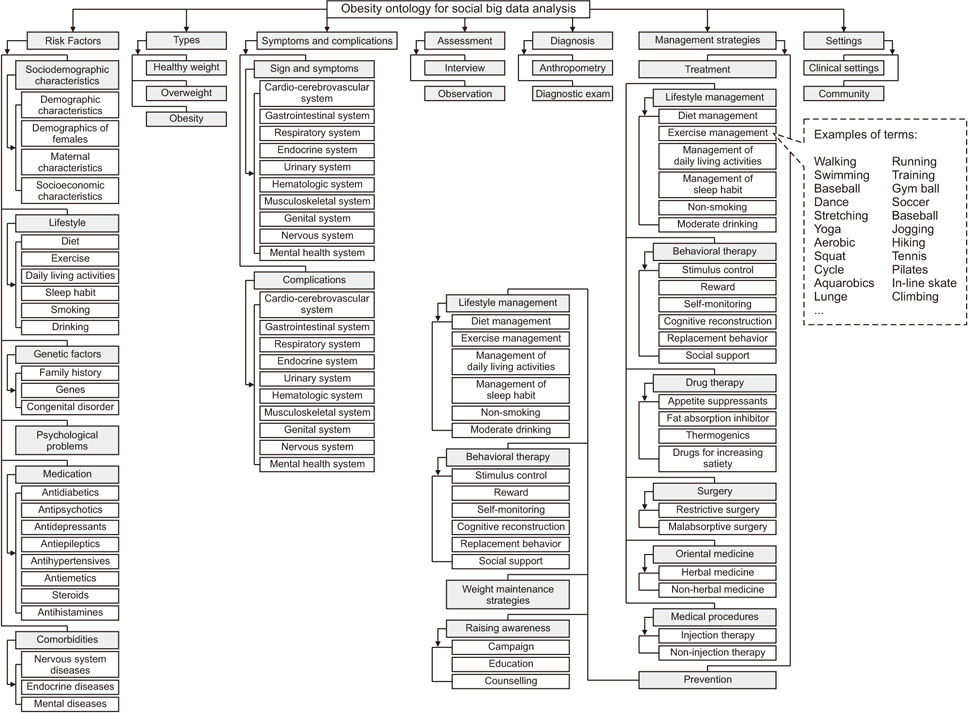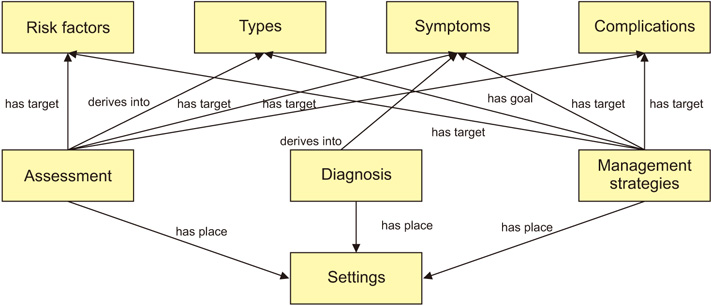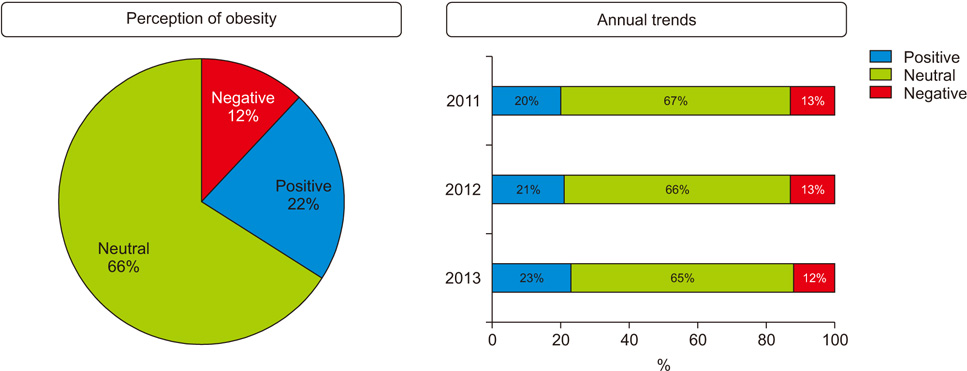Healthc Inform Res.
2017 Jul;23(3):159-168. 10.4258/hir.2017.23.3.159.
Development and Evaluation of an Obesity Ontology for Social Big Data Analysis
- Affiliations
-
- 1College of Nursing & Systems Biomedical Informatics Research Center, Seoul National University, Seoul, Korea. hapark@snu.ac.kr
- 2Department of Nursing, Samsung Medical Center, Sungkyunkwan University School of Medicine, Seoul, Korea.
- 3Research Institute of Nursing Science, Seoul National University, Seoul, Korea.
- 4Korea Institute for Health and Social Affairs, Sejong, Korea.
- KMID: 2403305
- DOI: http://doi.org/10.4258/hir.2017.23.3.159
Abstract
OBJECTIVES
The aim of this study was to develop and evaluate an obesity ontology as a framework for collecting and analyzing unstructured obesity-related social media posts.
METHODS
The obesity ontology was developed according to the "˜Ontology Development 101'. The coverage rate of the developed ontology was examined by mapping concepts and terms of the ontology with concepts and terms extracted from obesity-related Twitter postings. The structure and representative ability of the ontology was evaluated by nurse experts. We applied the ontology to the density analysis of keywords related to obesity types and management strategies and to the sentiment analysis of obesity and diet using social big data.
RESULTS
The developed obesity ontology was represented by 8 superclasses and 124 subordinate classes. The superclasses comprised "˜risk factors,'"˜types,'"˜symptoms,'"˜complications,'"˜assessment,'"˜diagnosis,'"˜management strategies,' and "˜settings.' The coverage rate of the ontology was 100% for the concepts and 87.8% for the terms. The evaluation scores for representative ability were higher than 4.0 out of 5.0 for all of the evaluation items. The density analysis of keywords revealed that the top-two posted types of obesity were abdomen and thigh, and the top-three posted management strategies were diet, exercise, and dietary supplements or drug therapy. Positive expressions of obesity-related postings has increased annually in the sentiment analysis.
CONCLUSIONS
It was found that the developed obesity ontology was useful to identify the most frequently used terms on obesity and opinions and emotions toward obesity posted by the geneal population on social media.
Keyword
Figure
Reference
-
1. Kuiler EW. From big data to knowledge: an ontological approach to big data analytics. Rev Policy Res. 2014; 31(4):311–318.
Article2. Song TM. Efficient utilization of big data on healthcare and welfare area. Healthc Welf Forum. 2012; 193:68–76.3. Song TM, Ryu S. Big data analysis framework for healthcare and social sectors in Korea. Healthc Inform Res. 2015; 21(1):3–9.
Article4. Harris JK, Moreland-Russell S, Tabak RG, Ruhr LR, Maier RC. Communication about childhood obesity on Twitter. Am J Public Health. 2014; 104(7):e62–e69.
Article5. Pagoto S, Schneider KL, Evans M, Waring ME, Appelhans B, Busch AM, et al. Tweeting it off: characteristics of adults who tweet about a weight loss attempt. J Am Med Inform Assoc. 2014; 21(6):1032–1037.
Article6. Kuebler M, Yom-Tov E, Pelleg D, Puhl RM, Muennig P. When overweight is the normal weight: an examination of obesity using a social media internet database. PLoS One. 2013; 8(9):e73479.
Article7. Song TM, Song J, An JY, Hayman LL, Woo JM. Psychological and social factors affecting Internet searches on suicide in Korea: a big data analysis of Google search trends. Yonsei Med J. 2014; 55(1):254–263.
Article8. Alt R, Wittwer M. Towards an ontology-based approach for social media analysis. In : Proceedings of the 22nd European Conference on Information Systems; 2014 Jun 9-11; Tel Aviv, Israel. p. 1–10.9. Yu EJ, Kim JC, Lee CY, Kim NG. Using ontologies for semantic text mining. J Inf Syst. 2012; 21(3):137–161.
Article10. Gruber TR. A translation approach to portable ontology specifications. Knowl Acquis. 1993; 5(2):199–220.
Article11. Noy NF, McGuinness DL. Ontology development 101: a guide to creating your first ontology [Internet]. Stanford(CA): Stanford University;c2015. cited at 2017 Jul 20. Available from: http://www.lsi.upc.edu/~bejar/aia/aiaweb/ontology101.pdf.12. Hammond RA, Levine R. The economic impact of obesity in the United States. Diabetes Metab Syndr Obes. 2010; 3:285–295.
Article13. Korea Centers for Disease Control & Prevention. Korea health statistics: Korea National Health and Nutrition Examination Survey 2013 (KNHANES VI-1) [Internet]. Cheongju: Korea Centers for Disease Control &Prevention;c2015. cited at 2017 Jul 20. Available from: https://knhanes.cdc.go.kr/knhanes/sub04/sub04_03.do?classType=7.14. Kang JH, Jeong BG, Cho YG, Song HR, Kim KA. Socioeconomic costs of overweight and obesity in Korean adults. J Korean Med Sci. 2011; 26(12):1533–1540.
Article15. Cristani M, Cuel R. A survey on ontology creation methodologies. Int J Semant Web Inf Syst. 2005; 1(2):49–69.
Article16. Hammar K. Towards an ontology design pattern quality model [dissertation]. Linkoping, Sweden: Linkoping University;2013.17. Scala PL, Di Pasquale D, Tresoldi D, Lafortuna CL, Rizzo G, Padula M. Ontology-supported clinical profiling for the evaluation of obesity and related comorbidities. Stud Health Technol Inform. 2012; 180:1025–1029.18. Jeon BJ, Ko IY. Ontology-based semi-automatic construction of Bayesian network models for diagnosing diseases in e-health applications. In : Proceedings of Frontiers in the Convergence of Bioscience and Information Technologies (FBIT); 2007 Oct 11-13; Jeju Island, Korea. p. 595–599.19. Zaragoza I, Alcaniz M, Botella C, Banos R, Guixeres J. An ontology for cognitive behavioral therapy: application to obesity. Stud Health Technol Inform. 2009; 144:16–18.20. Kim HY, Park HA, Min YH, Jeon E. Development of an obesity management ontology based on the nursing process for the mobile-device domain. J Med Internet Res. 2013; 15(6):e130.
Article21. Shaban-Nejad A, Buckeridge DL, Dube L. COPE: childhood obesity prevention [knowledge] enterprise. In : Proceedings of the 13th Conference on Artificial Intelligence in Medicine (AIME); 2011 Jul 2-6; Bled, Slovenia. p. 225–229.22. National Institute for Health and Clinical Excellence. Obesity: the prevention, identification, assessment and management of overweight and obesity in adults and children. London: National Institute for Health and Clinical Excellence;2006.23. Kang JH, Kang JG, Kang JH, Kim KG, Kim D, Kim KS, et al. Clinical practice guidelines for overweight and obesity in Korea. Seoul: Korean Society for the Study of Obesity;2012.24. Kehagias DD, Papadimitriou I, Hois J, Tzovaras D, Bateman J. A methodological approach for ontology evaluation and refinement. In : Proceedings of the ASK-IT Final Conference; 2008 Jun 26-27; Nuremburg, Germany. p. 1–13.25. Issa RR, Mutis I. Ontology in the AEC industry: a decade of research and development in architecture, engineering, and construction. Reston (VA): American Society of Civil Engineers;2015.
- Full Text Links
- Actions
-
Cited
- CITED
-
- Close
- Share
- Similar articles
-
- Correction: Development and Evaluation of an Obesity Ontology for Social Big Data Analysis
- Big Data Analysis Framework for Healthcare and Social Sectors in Korea
- Clinical research using medical big data
- Big Data: An Overview and Its Applications in Medicine and Aviation
- Current status and challenges on the big data of public sector in Korea





